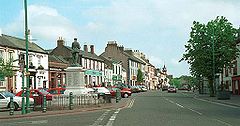Egremont, Cumbria
| Egremont | |
|---|---|
 Main Street, Egremont |
|
| Egremont shown within Cumbria | |
| Population | 8,194 (2011) |
| OS grid reference | NY008109 |
| Civil parish |
|
| District | |
| Shire county | |
| Region | |
| Country | England |
| Sovereign state | United Kingdom |
| Post town | EGREMONT |
| Postcode district | CA22 |
| Dialling code | 01946 |
| Police | Cumbria |
| Fire | Cumbria |
| Ambulance | North West |
| EU Parliament | North West England |
| UK Parliament | |
Egremont is a market town, civil parish and two electoral wards (North and South) in the Borough of Copeland in Cumbria, England, 5 miles (8.0 km) south of Whitehaven and on the River Ehen. Historically in Cumberland, the town, which lies at the foot of Uldale Valley and Dent Fell, has a long industrial heritage including dyeing, weaving and iron ore mining. It had a population of 7,444 in 2001, increasing to 8,194 at the 2011 Census.
The town's layout today is much the same as at the time of Richard de Lucy around 1200 with its wide Main Street opening out into the market place. The remains of the Norman castle, built in the 12th century, are situated at the southern end of Main Street near the market place.
Egremont was granted a charter for a market and annual fair by King Henry III in 1266. The resulting annual Crab Fair now hosts the World Gurning Championships.
The modern economy is built on services, media and tourism, together with nuclear industry at Sellafield.
Manufacturing industries have declined but service, new media and tourism industries have taken their place.
Egremont's Florence Mine was (until 2008) the last working deep iron ore mine left in Western Europe and produced ore, products for the cosmetics industry and high quality haematite for jewellery. Florence Mine can be found just south of Egremont.
A large local employer is the nuclear site at nearby Sellafield. The last few years have seen the running down of the nuclear power industry and the growth of the nuclear decommissioning industry.
...
Wikipedia

